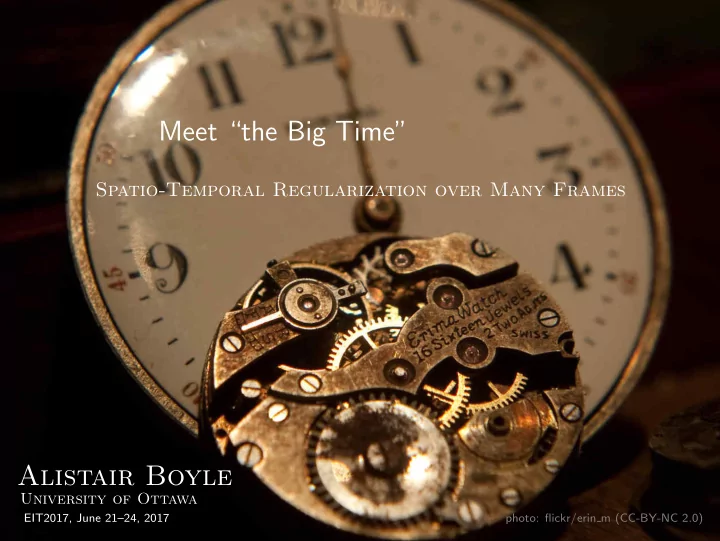

Meet “the Big Time” Spatio-Temporal Regularization over Many Frames Alistair Boyle University of Ottawa EIT2017, June 21–24, 2017 photo: flickr/erin m (CC-BY-NC 2.0)
Imaging a single frame of data Patient EIT Device Measurements Image! A. Boyle, 2017 University of Ottawa Spatio-Temporal Regularization over Many Frames 2 / 12
Monitoring 30 frames per second Patient EIT Device Many Frames of Measurements Many Frames of Measurements Many Frames of Measurements Many Frames of Measurements Movie! This requires heavier spatial regularization to get “smooth” frame-to-frame transitions, as much as possible. Is our movie over regularized? A. Boyle, 2017 University of Ottawa Spatio-Temporal Regularization over Many Frames 3 / 12
Example: A PEEP Trial Pig incremental/decremental PEEP trial 1 5000 frames @ 30 frames per second; GREIT 2 on each frame 1 I. Frerichs, P. A. Dargaville, T. Dudykevych, et al. , “Electrical impedance tomography: A method for monitoring regional lung aeration and tidal volume distribution?” Intensive Care Medicine , vol. 29, no. 12, pp. 2312–2316, Dec. 2003. 2 A. Adler, J. Arnold, R. Bayford, et al. , “Greit: A unified approach to 2D linear EIT reconstruction of lung images,” Physiological Measurement , vol. 30, no. 6, S35–S55, Jun. 2009. A. Boyle, 2017 University of Ottawa Spatio-Temporal Regularization over Many Frames 4 / 12
Patient Monitoring a typical solution: gate and average EIT Device ECG Device Many Frames of Measurements ECG data Many Frames of Measurements Many Frames of Measurements Many Frames of Measurements gate & avg A Few Frames of Measurements A Few Frames of Measurements Movie! A. Boyle, 2017 University of Ottawa Spatio-Temporal Regularization over Many Frames 5 / 12
Gauss-Newton: Spatial single-step or iterative x n +1 =( J T WJ + λ R T R ) − 1 � � J T Wb + λ R T R ( x ∗ − x n ) b – measurements J – Jacobian x ∗ – prior estimate W – inv noise cov x 0 – initial guess λ – hyperparameter x n – last estimate R – spatial regularization x n +1 – next estimate A. Boyle, 2017 University of Ottawa Spatio-Temporal Regularization over Many Frames 6 / 12
Gauss-Newton: Spatio-Temporal by block-wise expansion J R R R I ⊗ J = Γ ⊗ R = J R R R J R R R The spatial Gauss-Newton update becomes a spatio-temporal Gauss-Newton update 3 � − 1 ( I ⊗ J ) T ( I ⊗ W )( I ⊗ J ) + λ ( Γ ⊗ R ) T ( Γ ⊗ R ) � vec( X n +1 ) = ( I ⊗ J ) T ( I ⊗ W )vec( B ) + λ ( Γ ⊗ R ) T ( Γ ⊗ R )vec( X ∗ − X n ) � � ... can be simplified a bit but still has the same storage requirements n Runtime (s) o 100 t w e N - s s u a 50 G 1 10 20 Frames exponential memory storage and runtime growth as # frames, squared 3 T. Dai, M. Soleimani, and A. Adler, “EIT image reconstruction with four dimensional regularization,” Medical & Biological Engineering & Computing , vol. 46, no. 9, pp. 889–899, 2008. A. Boyle, 2017 University of Ottawa Spatio-Temporal Regularization over Many Frames 7 / 12
photo: flickr/jamesyu (CC-BY-NC-SA 2.0)
Kronecker product identity identity: vec( AXB ) = vec( C ) = ( B T ⊗ A )vec( X ) which transforms our spatio-temporal Gauss-Newton update into vec( J T WJX n +1 + λ R T RX n +1 ΓΓ T ) = � J T WB + λ R T R ( X ∗ − X n ) ΓΓ T � vec Note that we’ve removed all the Kronecker products that blew up our matrices, but we now have X n +1 in the middle of the equation A. Boyle, 2017 University of Ottawa Spatio-Temporal Regularization over Many Frames 9 / 12
Inner Conjugate Gradient vec( J T WJX n +1 + λ R T RX n +1 ΓΓ T ) = � J T WB + λ R T R ( X ∗ − X n ) ΓΓ T � vec Use an iterative Conjugate Gradient 4 solution in place of direct left-divide (LU decomposition). left-hand side computed on-the-fly at each inner CG iteration right-hand side computed once at each outer GN iteration each side should be computed to minimize matrix sizes, maximize sparsity ... still slow until we limit the number of iterations, watch convergence and adjust stopping criteria, which could be done rigourously 5 4 J. Shewchuk, “An introduction to the conjugate gradient method without the agonizing pain,” Carnegie Mellon University, Tech. Rep., 1994. 5 A. Rieder, “Inexact newton regularization using conjugate gradients as inner iteration,” SIAM Journal on Numerical Analysis , vol. 43, no. 2, pp. 604–622, 2006. A. Boyle, 2017 University of Ottawa Spatio-Temporal Regularization over Many Frames 10 / 12
Better and numerically equivalent 100 132.3 s Gauss-Newton Runtime (s) 10 1 0.41 s Conjugate Gradient 0.1 1 10 20 Frames A. Boyle, 2017 University of Ottawa Spatio-Temporal Regularization over Many Frames 11 / 12
Napkin View what: monitoring approaches lead to time series data, lots of data @ 30 f/s! why: do we filter data frames over time (ala FBP for spatial) or “Can we do better?” how: regularize over space and time... Spatio-Temporal but: math by boxes... it gets too big! how: a Kronecker product identity that almost works how: “But we don’t do that!” .. Conjugate Gradients bonus: cyclical events ... ECG-gated data bonus: regional spatio-temporal regularization by block-wise matrices A. Boyle, 2017 University of Ottawa Spatio-Temporal Regularization over Many Frames 12 / 12
Recommend
More recommend